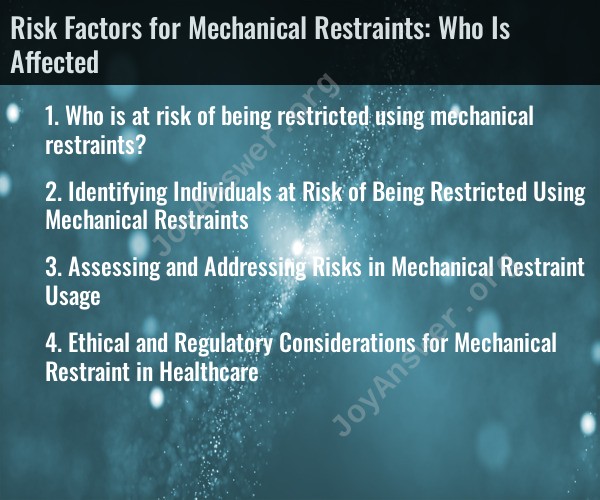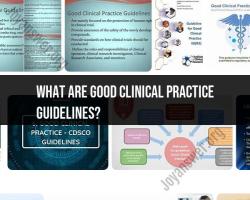Who is at risk of being restricted using mechanical restraints?
Mechanical restraints are typically used in healthcare and institutional settings to restrict the movement of individuals for safety or medical reasons. The decision to use mechanical restraints is governed by strict regulations and guidelines to ensure the safety and well-being of all individuals involved. People at risk of being subjected to mechanical restraints include:
Hospital Patients: Mechanical restraints may be used on patients in hospitals, particularly in psychiatric or emergency departments, to prevent harm to themselves or others when they are at risk of self-injury, suicide, or violence.
Psychiatric Patients: Individuals with severe mental health conditions may be at risk of being restrained if they exhibit violent or self-destructive behavior that poses a danger to themselves or those around them. However, the use of restraints in psychiatric settings is subject to strict regulations and guidelines.
Long-Term Care Residents: Residents of long-term care facilities, such as nursing homes or assisted living facilities, may be restrained if they are at risk of falls or injury, or if they exhibit aggressive behavior that endangers themselves or other residents.
Correctional Facilities: In prisons and jails, mechanical restraints may be used to control inmates during transport, medical treatment, or in emergency situations. Restraints are typically used in accordance with specific protocols and regulations.
Children and Adolescents: In some cases, children and adolescents may be restrained if they exhibit extreme behavioral problems, aggression, or self-harming tendencies. The use of restraints on minors is subject to strict guidelines and regulations.
Individuals with Cognitive Impairments: People with cognitive impairments, such as dementia or developmental disabilities, may be restrained if they are at risk of wandering, falling, or engaging in behavior that could harm themselves or others. Restraints are often used as a last resort in such cases.
People with Neurological Conditions: Individuals with neurological conditions that cause severe motor or cognitive impairments may be restrained to prevent injury or to facilitate medical procedures. For example, restraints may be used during certain types of surgery to ensure a patient's safety.
It's important to emphasize that the use of mechanical restraints is a highly regulated practice, and there are legal and ethical guidelines that must be followed to safeguard the rights and well-being of individuals. The decision to use restraints should be made based on a thorough assessment of the individual's condition and risk factors, and it should be implemented only when less restrictive alternatives have been considered and deemed ineffective or unsafe. Additionally, the use of restraints should be temporary and closely monitored to minimize the risk of physical and psychological harm.
Identifying Individuals at Risk of Being Restricted Using Mechanical Restraints
Mechanical restraints are physical devices that are used to restrict a person's movement. They are often used in healthcare settings to prevent patients from harming themselves or others. However, mechanical restraints can also be misused and can lead to serious injuries or even death.
There are a number of factors that can put a person at risk of being restricted using mechanical restraints. Some of these factors include:
- Age: Older adults and young children are more likely to be restrained than other age groups.
- Cognitive impairment: People with cognitive impairments, such as dementia or delirium, are more likely to be restrained than people with normal cognitive function.
- Mental illness: People with mental illnesses, such as schizophrenia or bipolar disorder, are more likely to be restrained than people without mental illnesses.
- Substance abuse: People who are intoxicated or withdrawing from drugs or alcohol are more likely to be restrained than people who are not substance abusers.
- Physical illness: People with physical illnesses, such as delirium tremens or seizures, are more likely to be restrained than people without physical illnesses.
Assessing and Addressing Risks in Mechanical Restraint Usage
Before using mechanical restraints, it is important to assess the patient's risk of harm to themselves or others. This assessment should include the following factors:
- The patient's mental state: Is the patient agitated, aggressive, or confused?
- The patient's physical condition: Is the patient at risk of falling or injuring themselves?
- The patient's medical history: Does the patient have a history of violence or self-harm?
- The patient's environment: Is the patient's environment safe and secure?
If the patient is determined to be at risk of harm, mechanical restraints should only be used as a last resort. Other less restrictive interventions, such as verbal de-escalation or seclusion, should be tried first.
If mechanical restraints must be used, it is important to use them safely and effectively. The following steps should be taken:
- Explain the need for restraints to the patient.
- Use the least restrictive restraints possible.
- Apply restraints in a way that does not cause pain or discomfort.
- Monitor the patient closely while they are restrained.
- Remove the restraints as soon as possible.
Ethical and Regulatory Considerations for Mechanical Restraint in Healthcare
The use of mechanical restraints in healthcare is a complex issue with ethical and regulatory considerations.
On the one hand, mechanical restraints can be necessary to protect patients from harming themselves or others. On the other hand, mechanical restraints can also be misused and can lead to serious injuries or even death.
Healthcare professionals have a duty to protect their patients from harm. However, they also have a duty to respect their patients' autonomy and to use the least restrictive interventions possible.
The following ethical and regulatory considerations should be taken into account when using mechanical restraints in healthcare:
- Informed consent: Patients have a right to informed consent before being subjected to any medical procedure, including the use of mechanical restraints. This means that patients must be informed of the risks and benefits of restraints and must give their consent before they are applied.
- Least restrictive intervention: Healthcare professionals should use the least restrictive intervention possible to control a patient's behavior. This means that mechanical restraints should only be used as a last resort.
- Patient monitoring: Patients who are restrained should be monitored closely to ensure their safety and well-being.
- Documentation: The use of mechanical restraints must be documented in the patient's medical record. This documentation should include the reason for the restraints, the type of restraints used, and the time and date the restraints were applied and removed.
Conclusion
The use of mechanical restraints in healthcare is a complex issue with ethical and regulatory considerations. Healthcare professionals must carefully balance the need to protect patients from harm with the need to respect their autonomy and to use the least restrictive interventions possible.












